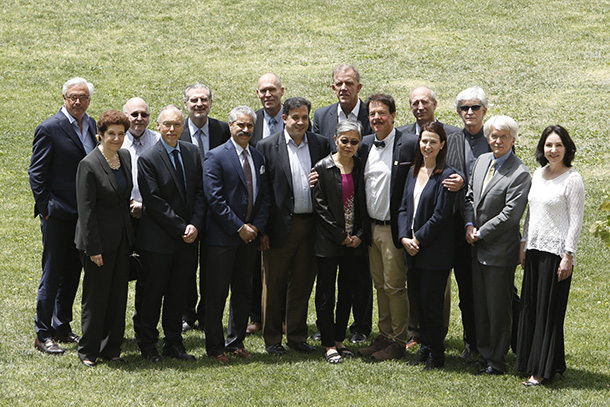Sixteen of the world’s top Alzheimer’s disease researchers shared their unpublished research at a symposium designed to fast track prevention, treatment and a cure for the debilitating disease that affects 1 in 3 seniors.
Rohit Varma, MD, MPH, dean of the Keck School of Medicine of USC and director of the USC Gayle and Edward Roski Eye Institute, welcomed the elite group to the fourth annual Zilkha Symposium on Alzheimer Disease and Related Disorders.
“I am delighted to be hosting this conference, which brings together the best and the brightest physician-scientists from around the world to study the new, basic, translational and clinical efforts in the field of Alzheimer’s and related neurodegenerative disorders,” Varma said. “We hope that with your wisdom, insight and hard work, we will end the scourge of this disease.”
Rudolph Tanzi, PhD, of Harvard University; David Holtzman, MD, of Washington University; Virginia Man-Yee Lee, PhD, and John Trojanowski, MD, PhD, of the University of Pennsylvania; Kaj Blennow, MD, PhD, of University of Gothenburg in Sweden; Roger Nitsch, MD, of the University of Zurich; Christer Betsholtz, MD, PhD, of Uppsala Universitet in Sweden; and Ronald Petersen, MD, PhD, of Mayo Clinic College of Medicine were some of the researchers who joined Keck School scientists Berislav Zlokovic, MD, PhD, and Paul Aisen, MD, to present their new findings.
Alzheimer’s starts with amyloid buildup
Alzheimer’s symptoms start to appear about 15 years after sticky amyloid proteins dirty the brain, said Aisen, professor of neurology and director of the USC Alzheimer’s Therapeutic Research Institute, which leads eight clinical trials on the disease.
Citing data from the ongoing Alzheimer’s Disease Neuroimaging Initiative study, Aisen said about 80 percent of participants with amyloid deposits in their brain but no Alzheimer’s symptoms developed symptoms of the disease during the next nine years. Comparatively, only 20 percent of people without amyloid deposits later developed similar symptoms.
“I think we need to carry this study a little further until we can say almost everyone with elevated amyloid will progress to symptomatic AD,” Aisen said. “It seems reasonable to expect that if we start anti-amyloid therapy 15 years prior to the expected onset of symptoms, we should be able to prevent the development of clinical Alzheimer’s disease.”
Aisen is enrolling healthy individuals showing no symptoms of Alzheimer’s into clinical studies to trace the development of the disease over time.
Understanding the illness and how it progresses will aid in the development of a “liquid biopsy” blood test that will inform doctors which individuals are at high-risk for Alzheimer’s.
In the future, once doctors identify that a patient has early buildup of amyloid, they could prescribe a drug to eliminate it. Afterward, individuals might take a drug such as a BACE-inhibitor to prevent amyloid buildup, Aisen said.
Eventually, doctors will be able to identify people likely to develop Alzheimer’s through biomarkers found in blood draws, Aisen said. This will facilitate preventive treatment.
The brain’s vascular system
Zlokovic, director of the Zilkha Neurogenetic Institute, challenged Aisen’s amyloid hypothesis, saying amyloid isn’t ground zero for neurodegeneration.
“I’m a little worried if we say Alzheimer’s is exclusively amyloid-derived neurodegeneration,” said Zlokovic, who also is chair and professor of physiology and biophysics. “I would say that this is a very complex, multifactorial disease that is driven by genetic, vascular and environmental factors that all can influence disease onset and progression.
“Disease onset may or may not involve amyloid at all,” he noted.
Problems in brain circulation such as subtle damage to the smallest brain vessels — capillaries — loss of cerebrovascular integrity and blood flow changes happen early, are integral to disease progression and can precede amyloid and tau pathology, according to recent studies, he explained.
Zlokovic is performing pioneering research on how leaks in the brain’s vascular system, the blood-brain barrier, cause a cascade of problems, including amyloid buildup. Age-related small vessel disease of the brain is a health epidemic of the 21st century, Zlokovic said. Small vessel disease contributes to about 45 percent of all dementias worldwide, including Alzheimer’s, he added.
“A healthy brain needs healthy blood vessels,” said Zlokovic, recently installed as the Mary Hayley and Selim Zilkha Chair in Alzheimer’s Disease Research. “The blood-brain barrier prevents entry into the brain of blood-derived toxic products, pathogens and cells.”
The first region of an aging brain to become leaky is the blood-brain barrier around the hippocampus — the center of learning and memory, Zlokovic said. When the brain’s capillaries become leaky, toxic, blood-derived products flood the brain and can trigger neurodegenerative changes and inflammatory response.
Due to the blood vessel problem, delivery of oxygen and glucose (a key energy metabolite for the brain) is grossly impaired and gets worse as Alzheimer’s progresses. Damaged blood vessels lose their ability to clear metabolic waste products from the brain, including amyloid proteins, causing buildup of the dangerous plaques, inflammation, loss of brain connections and ultimately loss of neurons leading to characteristic cognitive problems associated with Alzheimer’s.
Other researchers talked about new findings on how genes, germs, tau protein tangles and specific biomarkers are contributing to Alzheimer’s disease. In the end, the consensus was clear: Collaboration is necessary to solve the intricate and colossal Alzheimer’s problem.
More than 70 USC researchers across a range of disciplines are examining the health, societal and political effects and implications of Alzheimer’s.
“We look forward to hosting this symposium again next year,” Zlokovic said. “It’s critical for top Alzheimer’s experts to get together and share their unpublished findings, concepts and state-of-the art approaches so that scientific barriers are removed, and we all work together to arrest and reverse this devastating disease.”
— Zen Vuong


